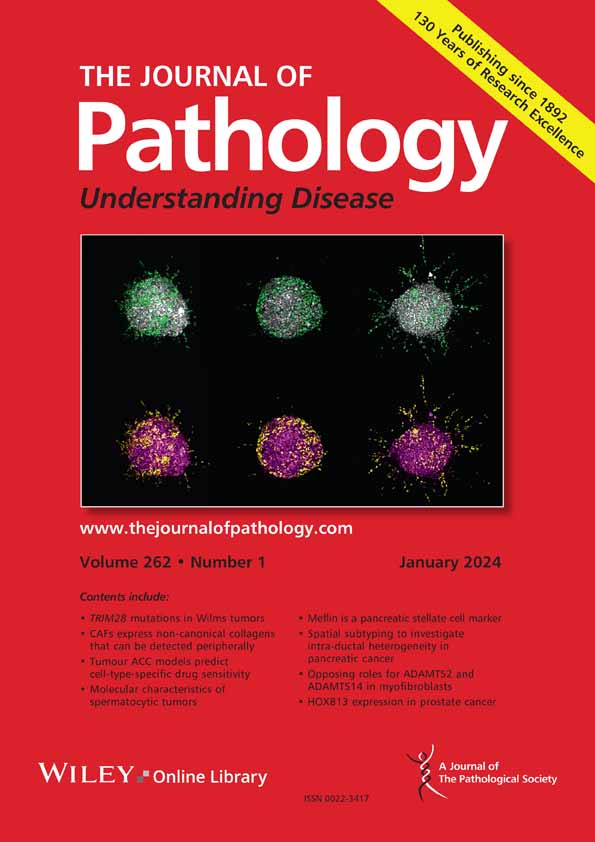Fang Liu, Qingchun Liang, Li Li, Yuan Gong, Mingxi Li, Liyun Feng, An Chen, Yuanzhi Ye, Zirong Lan, Yining Li, Jing-Song Ou, Lihe Lu, Jianyun Yan
求助PDF
{"title":"Thrombospondin-1 binds to integrin β3 to inhibit vascular calcification through suppression of NF-κB pathway","authors":"Fang Liu, Qingchun Liang, Li Li, Yuan Gong, Mingxi Li, Liyun Feng, An Chen, Yuanzhi Ye, Zirong Lan, Yining Li, Jing-Song Ou, Lihe Lu, Jianyun Yan","doi":"10.1002/path.6417","DOIUrl":null,"url":null,"abstract":"<p>Vascular calcification is an important risk factor related to all-cause mortality of cardiovascular events in patients with chronic kidney disease (CKD). Vascular extracellular matrix (ECM) proteins have been demonstrated to regulate vascular calcification. ECM protein thrombospondin 1 (THBS1/TSP-1) plays a critical role in the regulation of vascular diseases. However, whether THBS1 is involved in vascular calcification in CKD patients remains unclear. In this study, RNA sequencing datasets from the Gene Expression Omnibus (GEO) database GSE146638 showed that THBS1 was upregulated in the aortas of CKD rats. Enzyme-linked immunosorbent assay (elisa) revealed that serum THBS1 levels were increased in CKD patients with thoracic calcification. Western blotting and immunofluorescence analysis showed that THBS1 expression was increased in calcified vascular smooth muscle cells (VSMCs) and arteries. <i>THBS1</i> knockdown exacerbated rat VSMC calcification induced by high phosphorus and calcium, as shown by Alizarin red staining and calcium content assays. Conversely, <i>THBS1</i> overexpression attenuated VSMC calcification and abdominal aortic calcification in rats with CKD. Moreover, addition of recombinant THBS1 protein inhibited calcification of VSMC<sub>S</sub> and human arterial rings. Smooth muscle cell-specific knockout of <i>THBS1</i> mice treated with vitamin D3 displayed aggravated aortic calcification. Mechanistically, the protein–protein interaction database STRING (http://string-db.org/) analysis and coimmunoprecipitation assays revealed THBS1 bound to integrin β3. Reduction of integrin β3 levels abrogated the protective effect of THBS1 on vascular calcification. RNA-seq analysis revealed that <i>THBS1</i> overexpression modulated the nuclear factor-kappa B (NF-κB) signaling pathway. Of note, the inhibitory effect of <i>THBS1</i> overexpression on the NF-κB signal was abolished by knockdown of integrin β3. In conclusion, THBS1 interacts with integrin β3 to inhibit vascular calcification through suppression of NF-κB signal, suggesting a promising therapeutic target for vascular calcification in CKD. © 2025 The Pathological Society of Great Britain and Ireland.</p>","PeriodicalId":232,"journal":{"name":"The Journal of Pathology","volume":"266 1","pages":"109-123"},"PeriodicalIF":5.2000,"publicationDate":"2025-03-14","publicationTypes":"Journal Article","fieldsOfStudy":null,"isOpenAccess":false,"openAccessPdf":"","citationCount":"0","resultStr":null,"platform":"Semanticscholar","paperid":null,"PeriodicalName":"The Journal of Pathology","FirstCategoryId":"3","ListUrlMain":"https://pathsocjournals.onlinelibrary.wiley.com/doi/10.1002/path.6417","RegionNum":2,"RegionCategory":"医学","ArticlePicture":[],"TitleCN":null,"AbstractTextCN":null,"PMCID":null,"EPubDate":"","PubModel":"","JCR":"Q1","JCRName":"ONCOLOGY","Score":null,"Total":0}
引用次数: 0
引用
批量引用
Abstract
Vascular calcification is an important risk factor related to all-cause mortality of cardiovascular events in patients with chronic kidney disease (CKD). Vascular extracellular matrix (ECM) proteins have been demonstrated to regulate vascular calcification. ECM protein thrombospondin 1 (THBS1/TSP-1) plays a critical role in the regulation of vascular diseases. However, whether THBS1 is involved in vascular calcification in CKD patients remains unclear. In this study, RNA sequencing datasets from the Gene Expression Omnibus (GEO) database GSE146638 showed that THBS1 was upregulated in the aortas of CKD rats. Enzyme-linked immunosorbent assay (elisa) revealed that serum THBS1 levels were increased in CKD patients with thoracic calcification. Western blotting and immunofluorescence analysis showed that THBS1 expression was increased in calcified vascular smooth muscle cells (VSMCs) and arteries. THBS1 knockdown exacerbated rat VSMC calcification induced by high phosphorus and calcium, as shown by Alizarin red staining and calcium content assays. Conversely, THBS1 overexpression attenuated VSMC calcification and abdominal aortic calcification in rats with CKD. Moreover, addition of recombinant THBS1 protein inhibited calcification of VSMCS and human arterial rings. Smooth muscle cell-specific knockout of THBS1 mice treated with vitamin D3 displayed aggravated aortic calcification. Mechanistically, the protein–protein interaction database STRING (http://string-db.org/) analysis and coimmunoprecipitation assays revealed THBS1 bound to integrin β3. Reduction of integrin β3 levels abrogated the protective effect of THBS1 on vascular calcification. RNA-seq analysis revealed that THBS1 overexpression modulated the nuclear factor-kappa B (NF-κB) signaling pathway. Of note, the inhibitory effect of THBS1 overexpression on the NF-κB signal was abolished by knockdown of integrin β3. In conclusion, THBS1 interacts with integrin β3 to inhibit vascular calcification through suppression of NF-κB signal, suggesting a promising therapeutic target for vascular calcification in CKD. © 2025 The Pathological Society of Great Britain and Ireland.
血小板反应蛋白-1与整合素β3结合,通过抑制NF-κB途径抑制血管钙化。
血管钙化是与慢性肾脏病(CKD)患者心血管事件全因死亡率相关的一个重要风险因素。血管细胞外基质(ECM)蛋白已被证实能调节血管钙化。细胞外基质蛋白血栓松蛋白 1(THBS1/TSP-1)在血管疾病的调控中起着至关重要的作用。然而,THBS1 是否参与了 CKD 患者的血管钙化仍不清楚。在这项研究中,来自基因表达总库(GEO)数据库 GSE146638 的 RNA 测序数据集显示,THBS1 在 CKD 大鼠的主动脉中上调。酶联免疫吸附试验(elisa)显示,伴有胸廓钙化的 CKD 患者血清中 THBS1 水平升高。Western印迹和免疫荧光分析表明,THBS1在钙化的血管平滑肌细胞(VSMC)和动脉中表达增加。茜素红染色和钙含量测定显示,THBS1基因敲除会加剧高磷和高钙诱导的大鼠血管平滑肌细胞钙化。相反,THBS1 的过表达会减轻慢性肾脏病大鼠血管内皮细胞钙化和腹主动脉钙化。此外,添加重组 THBS1 蛋白可抑制 VSMCS 和人体动脉环的钙化。用维生素 D3 治疗平滑肌细胞特异性敲除 THBS1 的小鼠显示主动脉钙化加剧。从机理上讲,蛋白质-蛋白质相互作用数据库 STRING (http://string-db.org/) 分析和共沉淀试验显示 THBS1 与整合素 β3 结合。降低整合素β3的水平会减弱THBS1对血管钙化的保护作用。RNA-seq分析显示,THBS1的过表达调节了核因子-kappa B(NF-κB)信号通路。值得注意的是,通过敲除整合素β3,THBS1过表达对NF-κB信号的抑制作用被取消。总之,THBS1与整合素β3相互作用,通过抑制NF-κB信号来抑制血管钙化,是治疗CKD血管钙化的一个很有前景的靶点。© 2025 大不列颠及爱尔兰病理学会。
本文章由计算机程序翻译,如有差异,请以英文原文为准。





 求助内容:
求助内容: 应助结果提醒方式:
应助结果提醒方式:


